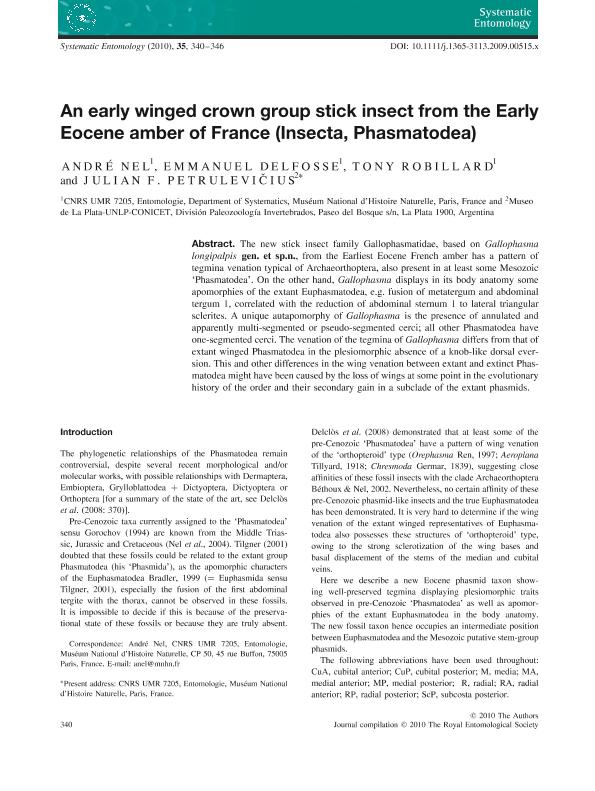Artículo
An early winged crown group stick insect from the Early Eocene amber of France (Insecta, Phasmatodea)
Fecha de publicación:
04/2010
Editorial:
Wiley Blackwell Publishing, Inc
Revista:
Systematic Entomology (print)
ISSN:
0307-6970
Idioma:
Inglés
Tipo de recurso:
Artículo publicado
Clasificación temática:
Resumen
The new stick insect family Gallophasmatidae, based on Gallophasma longipalpis gen. et sp.n., from the Earliest Eocene French amber has a pattern of tegmina venation typical of Archaeorthoptera, also present in at least some Mesozoic 'Phasmatodea'. On the other hand, Gallophasma displays in its body anatomy some apomorphies of the extant Euphasmatodea, e.g. fusion of metatergum and abdominal tergum 1, correlated with the reduction of abdominal sternum 1 to lateral triangular sclerites. A unique autapomorphy of Gallophasma is the presence of annulated and apparently multi-segmented or pseudo-segmented cerci; all other Phasmatodea have one-segmented cerci. The venation of the tegmina of Gallophasma differs from that of extant winged Phasmatodea in the plesiomorphic absence of a knob-like dorsal eversion. This and other differences in the wing venation between extant and extinct Phasmatodea might have been caused by the loss of wings at some point in the evolutionary history of the order and their secondary gain in a subclade of the extant phasmids.
Palabras clave:
Eocene
,
ambar
,
Phasmatodea
,
Francia
Archivos asociados
Licencia
Identificadores
Colecciones
Articulos(CCT - LA PLATA)
Articulos de CTRO.CIENTIFICO TECNOL.CONICET - LA PLATA
Articulos de CTRO.CIENTIFICO TECNOL.CONICET - LA PLATA
Citación
Nel, André; Delfosse, Emmanuel; Robillard, Tony; Petrulevicius, Julian Fernando; An early winged crown group stick insect from the Early Eocene amber of France (Insecta, Phasmatodea); Wiley Blackwell Publishing, Inc; Systematic Entomology (print); 35; 2; 4-2010; 340-346
Compartir
Altmétricas




